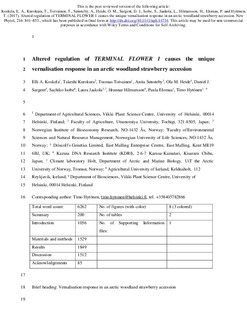Altered regulation of TERMINAL FLOWER 1 causes the unique vernalisation response in an arctic woodland strawberry accession
Koskela, Elli A.; Kurokura, Takeshi; Toivainen, Tuomas; Sønsteby, Anita; Heide, Ola M; Sargent, Daniel J.; Isobe, Sachiko; Jaakola, Laura; Hilmarsson, Hrannar; Elomaa, Paula; Hytönen, Timo
Journal article, Peer reviewed
Accepted version
Permanent lenke
http://hdl.handle.net/11250/2475893Utgivelsesdato
2017-11Metadata
Vis full innførselSamlinger
- Publikasjoner fra CRIStin - NIBIO [4575]
- Vitenskapelige artikler [1416]
Sammendrag
• Vernalisation requirement is an agriculturally important trait that postpones the development of cold-sensitive floral organs until the spring. The family Rosaceae includes many agriculturally important fruit and berry crops that suffer from crop losses caused by frost injury to overwintering flower buds. Recently, a vernalisation-requiring accession of the Rosaceae model woodland strawberry (Fragaria vesca) has been identified in northern Norway. Understanding the molecular basis of the vernalisation requirement in this accession would advance the development of strawberry cultivars better adapted to temperate climate. • We use gene silencing, gene expression analysis, genetic mapping and population genomics to study the genetic basis of the vernalisation requirement in woodland strawberry. • Our results indicate that the woodland strawberry vernalisation requirement is endemic to northern Norwegian population, and mapping data suggest the orthologue of TERMINAL FLOWER1 (FvTFL1) as the causal floral repressor. We demonstrate that exceptionally low temperatures are needed to downregulate FvTFL1 and to make these plants competent to induce flowering at low postvernalisation temperatures in the spring. • We show that altered regulation of FvTFL1 in the northern Norwegian woodland strawberry accession postpones flower induction until the spring, allowing plants to avoid winter injuries of flower buds that commonly occur in temperate regions.
